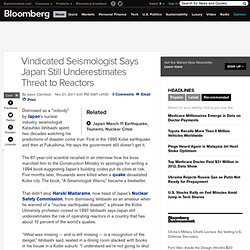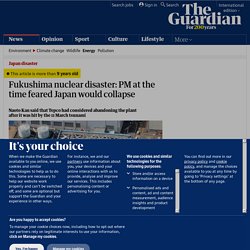

Why Fukushima death toll projections are based on junk science. The media is abuzz this morning with the first study attempting to quantify expected cancer deaths which may result from Fukushima. Written by Ten Hoeve and Mark Jacobson from Stanford University, the paper ‘Worldwide health effects of the Fukushima Daiichi nuclear accident’ is published in the journal Energy and Environmental Science (free PDF copy). I will say upfront that I think the study is worse than useless. Jacobson (Hoeve is a former PhD student of his) is a long-time anti-nuclear and pro-renewables advocate, and (as I show below) clearly has an agenda to raise further fears about the health impacts of Fukushima and nuclear power in general.
However, in this deeply flawed paper he succeeds only in illustrating some of the absurdities in current radiological protection models, and that one thing we know for sure – even if those absurdities are ignored – is that the evacuation killed more people than the accident. And the next sentence is the key: Just 0.8% of children in 2001 Japanese control group had thyroid cysts or nodules — 36% in Fukushima study. Architect of Reactor 3 warns of massive hydrovolcanic explosion. Posted by Mochizuki on November 19th, 2011 · 146 Comments Architect of Fukushima Daiichi Reactor 3, Uehara Haruo, the former president of Saga University had an interview on 11/17/2011.

In this interview, he admitted Tepco’s explanation does not make sense, and that the China syndrome is inevitable. He stated that considering 8 months have passed since 311 without any improvement, it is inevitable that melted fuel went out of the container vessel and sank underground, which is called China syndrome. He added, if fuel has reaches a underground water vein, it will cause contamination of underground water, soil contamination and sea contamination.
Moreover, if the underground water vein keeps being heated for long time, a massive hydrovolcanic explosion will be caused. He also warned radioactive debris is spreading in Pacific Ocean. (Source) 3/30から5/5まで、おれ氏はキプロスを調査しておりもす。 調査費は自腹で、見積もりを出す以前にキプロスに飛び込んでしまいましたが、未開の地を開拓するサソタ・オレオ号にみなさんのオレオを投資して頂けると嬉しいです。 現在の総オレオ/目標オレオ:62/222.5. Japan Quake Threat Scientist Was Dismissed. Dismissed as a “nobody” by Japan’s nuclear industry, seismologist Katsuhiko Ishibashi spent two decades watching his predictions of disaster come true: First in the 1995 Kobe earthquake and then at Fukushima.

He says the government still doesn’t get it. The 67-year-old scientist recalled in an interview how his boss marched him to the Construction Ministry to apologize for writing a 1994 book suggesting Japan’s building codes put its cities at risk. Five months later, thousands were killed when a quake devastated Kobe city. The book, “A Seismologist Warns,” became a bestseller. That didn’t stop Haruki Madarame, now head of Japan’s Nuclear Safety Commission, from dismissing Ishibashi as an amateur when he warned of a “nuclear earthquake disaster,” a phrase the Kobe University professor coined in 1997.
“What was missing -- and is still missing -- is a recognition of the danger,” Ishibashi said, seated in a dining room stacked with books in his house in a Kobe suburb. Censorship. FUKUSHIMA the effects of radiation on daily life. Fukushima nuclear disaster: PM at the time feared Japan would collapse. Japan's prime minister at the height of the nuclear crisis has said he feared the country would collapse, and revealed that Tepco had considered abandoning the Fukushima Daiichi power plant after it was hit by the 11 March tsunami.

In candid interviews with Japanese newspapers, Naoto Kan, who resigned this month, said that at one point he believed the disaster could become many times worse than Chernobyl. "It was truly a spine-chilling thought," he told the Tokyo Shimbun, adding that he foresaw a situation in which greater Tokyo's 30 million people would have to be evacuated, a move that would "compromise the very existence of the Japanese nation". In the first week of the crisis Tepco played down speculation that fuel rods had melted after the quake and tsunami crippled the reactors' cooling systems.
"The power was totally lost and there was no cooling capacity," Kan said. "I knew what that meant and I thought, 'This is going to be a disaster'. " Mysterious person in radiation suit appears on Fukushima webcam (VIDEOS) « ENENEWS.COM. Jeremy Rifkin - Le nucléaire est mort - une vidéo Expression Libre. Jean-Pierre Petit extrait DVD sur le nucléaire et les manières d'en sortir - une vidéo Actu et Politique. Inside report from Fukushima nuclear reactor evacuation zone. Japanese government killing its own people in Fukushima Wikileaks. Photography. Data and maps. Infographics.
General knowledge. Press. Veille France. Veille japon.